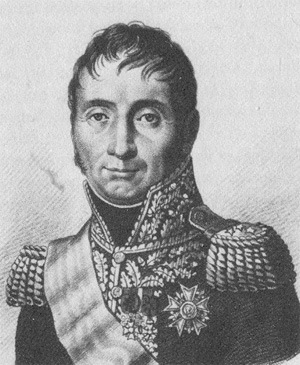General Jean Dominique Compans

Born: June 26, 1769
Place of Birth: Salies-du-Salat, Haute-Garonne, France
Died: November 10, 1845
Place of Death: Blagnac, France
Arc de Triomphe: COMPANS on the east pillar
The son of a merchant, Jean Dominique Compans was originally intended for the priesthood but instead he began a military career as a capitaine in the 3rd Battalion of Volunteers of Haute-Garonne in October of 1791. The next year he served with the Army of the Alps and then in 1793 he was sent to the Army of Italy. During this time he took part in the defense of the camp of Braous and served at the action of the camp of Bruis before serving during the attack of Lantosca. Towards the end of the year he served at the Siege of Toulon and in November he was promoted to chef de bataillon. In 1794 Compans joined the staff of General Dugommier and he served in the Army of the Eastern Pyrenees. With this army he served at Boulou, Junquera, and Montagne Noire where he seized many redoubts. In June of 1795 he was promoted to chef de brigade and once peace was signed with Spain he was then given an administrative position in the 9th military division.
In August of 1798 Compans became chief of staff to General Grenier in the Army of Italy. The next year he distinguished himself in multiple combats, including the fighting at Vaprio, Pacetto, and San Giuliano. For his accomplishments he was promoted to général de brigade. In September he took command of Grenier's division when Grenier took command of an entire wing of the army. With his new command, Compans seized Fossano and Savigliano before being placed in charge of the advance guard. That November he led the advance guard into action at Morozzo, the bridge of Borghetto, San Dalmazzo, Robillante, and Verante. By this time Compans had gained such a reputation in Italy for discipline of his troops and protection of peasants that if he got lost and accidentally walked into a Barbet insurgent camp, the insurgents would escort him back to a French outpost. Further enhancing his reputation, that year some of his soldiers refused to march due to their lack of boots and Compans convinced them otherwise by taking off his own boots and leading by example.1
In April of 1800 General Compans was still serving in Italy, now under Suchet in Pouget's division. After failing in the attack of Mont Settépani, he attacked again two days later and successfully seized it. On April 20, he was wounded by a shot during an attack on San Giacomo. That December Compans served in Loison's division and he fought at Volta, Monzembano, Borghetto, Villafranca, Montebello, and Spaziano. In 1801 he commanded the province of Coni and in 1803 he joined Suchet's division at the camp of Saint-Omer.
With the Grande Armée marching to war in 1805, Compans was named chief of staff to Marshal Lannes' V Corps. He participated throughout the campaign that year and served at its conclusion at the Battle of Austerlitz where he was wounded. A few weeks later he took command of Thiébault's brigade in IV Corps. In 1806 he was appointed chief of staff to Marshal Soult's IV Corps and he took part in the campaign against Prussia. After fighting at the Battle of Jena, a month later he was promoted to général de division.
General Compans was named a Count of the Empire in 1808 and then he became the chief of staff to Marshal Davout's Army of Germany. During the Danube campaign of 1809 he distinguished himself at Tengen and he also fought at Schierling. While Davout was absent from February of 1810 to February of 1811, Compans served as interim commander of the Army of Germany.
For the Russian campaign of 1812, Compans commanded the 5th Division of Davout's I Corps. He fought at Mohilew and Smolensk before being wounded by a shot to the shoulder at Borodino. While serving during the retreat, he fought at Maloyaroslavetz and Wiazma. During the campaigns of 1813 in Saxony he commanded the 20th Infantry Division of Marshal Marmont's VI Corps, fighting at Lützen, Bautzen, and Leipzig . Continuing to serve during the defense of France of 1814, in March of 1814 he fought at Sézanne, was defeated at Chailly, defended Meaux, and won a victory at Montsaigle before taking part in the defense of Paris.
After Napoleon's abdication in April of 1814, the restored Bourbons rewarded Compans with a Grand Cross of the Legion of Honor. In 1815 when Napoleon returned to power for the Hundred Days, Compans accepted Napoleon's rule and was named commander of the 6th Infantry Division of II Corps of the Army of the North. Compans however refused the command and was allowed to retire. After Napoleon's second abdication, the restored Bourbons named Compans a Peer of France. Compans participated in the trial of Marshal Ney where he voted for death.
Notes
Bibliography
- Divry, Arnauld. Les Noms Gravés sur l'Arc de Triomphe. Paris: L'Harmattan, 2017.
- Haythornthwaite, Philip J. Who Was Who in the Napoleonic Wars. London: Arms & Armour, 1998.
- Six, Georges. Dictionnaire Biographique des Généraux & Amiraux Français de la Révolution et de l'Empire (1792-1814). 2 vols. Paris: Gaston Saffroy, 2003.
Updated August 2024
© Nathan D. Jensen